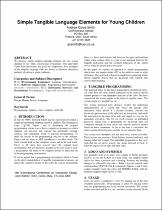JavaScript is disabled for your browser. Some features of this site may not work without it.
- ResearchSpace
- →
- Research Publications/Outputs
- →
- Conference Publications
- →
- View Item
| dc.contributor.author |
Smith, Andrew C

|
|
| dc.date.accessioned | 2009-10-13T12:59:22Z | |
| dc.date.available | 2009-10-13T12:59:22Z | |
| dc.date.issued | 2009-06 | |
| dc.identifier.citation | Smith, AC. 2009. Simple tangible language elements for young children. 8th International Conference on Interaction Design and Children (IDC), Como, Italy, 3-5 June, 2009. pp 288-289 | en |
| dc.identifier.isbn | 978605583952 | |
| dc.identifier.uri | http://hdl.handle.net/10204/3660 | |
| dc.description | 8th International Conference on Interaction Design and Children (IDC), Como, Italy, 3-5 June 2009 | en |
| dc.description.abstract | In this paper, researchers have proposed simple tangible language elements for very young children to use when constructing programmes. The equivalent Turtle Talk instructions are given for comparison. Two examples of the tangible language code are shown to illustrate alternative methods of solving a given challenge. | en |
| dc.language.iso | en | en |
| dc.subject | Simple tangible language | en |
| dc.subject | Young children | en |
| dc.subject | Turtle talk | en |
| dc.subject | Programming syntax | en |
| dc.subject | Tangible programming system | en |
| dc.subject | Tactile programming environment | en |
| dc.subject | Interaction design | en |
| dc.subject | Tangible language code | en |
| dc.title | Simple tangible language elements for young children | en |
| dc.type | Conference Presentation | en |
| dc.identifier.apacitation | Smith, A. C. (2009). Simple tangible language elements for young children. http://hdl.handle.net/10204/3660 | en_ZA |
| dc.identifier.chicagocitation | Smith, Andrew C. "Simple tangible language elements for young children." (2009): http://hdl.handle.net/10204/3660 | en_ZA |
| dc.identifier.vancouvercitation | Smith AC, Simple tangible language elements for young children; 2009. http://hdl.handle.net/10204/3660 . | en_ZA |
| dc.identifier.ris | TY - Conference Presentation AU - Smith, Andrew C AB - In this paper, researchers have proposed simple tangible language elements for very young children to use when constructing programmes. The equivalent Turtle Talk instructions are given for comparison. Two examples of the tangible language code are shown to illustrate alternative methods of solving a given challenge. DA - 2009-06 DB - ResearchSpace DP - CSIR KW - Simple tangible language KW - Young children KW - Turtle talk KW - Programming syntax KW - Tangible programming system KW - Tactile programming environment KW - Interaction design KW - Tangible language code LK - https://researchspace.csir.co.za PY - 2009 SM - 978605583952 T1 - Simple tangible language elements for young children TI - Simple tangible language elements for young children UR - http://hdl.handle.net/10204/3660 ER - | en_ZA |






